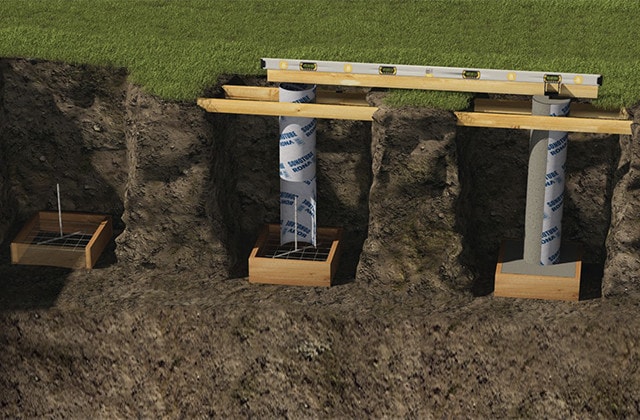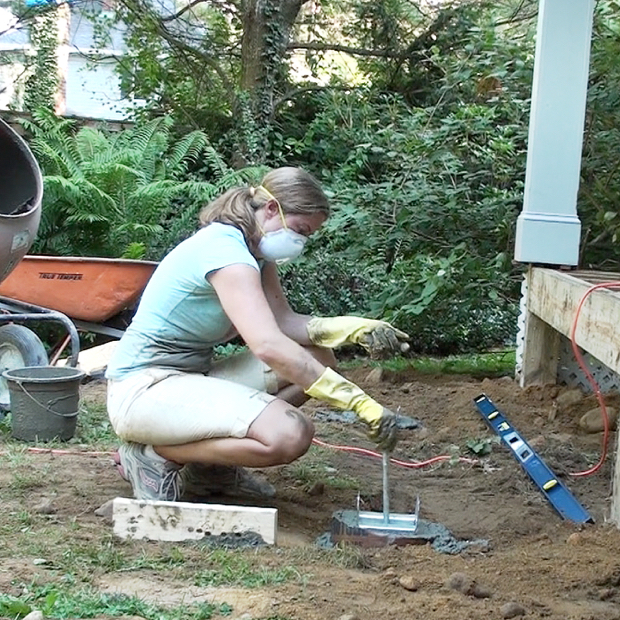Deck Footings Unveiled: Recognizing the Key Elements of a Reliable Deck Framework
Specialist Tips for Putting Up Deck Footings to Support Your Outdoor Room
When it pertains to building a deck, among the most crucial aspects to think about is the installation of proper footings. These footings are the foundation whereupon your outdoor room will relax, providing stability and support for many years ahead. However just what does it take to set up deck footings appropriately? In this discussion, we will explore experienced tips and methods that can assist make certain a durable and successful deck setup. From choosing the ideal kind of grounds to avoiding common mistakes, we will offer you with the expertise and understandings you need to with confidence begin on your deck-building trip. So, let's dive right in and discover the key to a strong and durable outdoor space.
Relevance of Correct Deck Footings
Proper deck grounds are crucial for making sure the stability and longevity of your exterior area. Without solid and correctly set up footings, your deck might become unpredictable, leading to safety risks and pricey repair work.

Along with security, proper deck footings likewise add to the durability of your exterior room (Deck Footings). Grounds that are developed and constructed to withstand the components and dirt problems in your area will certainly help prevent the deck from shifting or resolving with time. By guaranteeing the footings are effectively sized and set up, you can minimize the danger of damage to the deck framework, extending its life-span and minimizing the requirement for pricey repair services or replacements

Picking the Right Kind Of Grounds
When choosing the ideal type of footings for your deck, it is crucial to take into consideration variables such as dirt problems, local building regulations, and the general style of your outdoor space. The kind of footing you pick will certainly play a crucial role in ensuring the security and longevity of your deck.
One common type of footing is the concrete footing. Concrete grounds appropriate for many dirt conditions and supply excellent support for decks. They are usually set up listed below the frost line to stop changing and working out due to freezing and thawing cycles. One more choice is helical piers, which are perfect for locations with unsteady dirt or high water tables. These piers are screwed right into the ground and offer strong support for the deck.
Sometimes, you might require to utilize specific grounds, such as heap footings or deep structures, if you are developing a multi-level or large deck. These grounds are designed to distribute the weight of the deck over a bigger area, guaranteeing stability and preventing resolving or sinking.
Prior to picking a kind of ground, it is essential to speak with local building regulations and guidelines to make certain compliance. Additionally, consider the layout and planned usage of your exterior room. Variables such as the size, shape, and load-bearing demands of your deck will certainly influence the sort of footing that is most ideal.
Preparing the Ground for Footing Installment
To properly prepare the ground for footing setup, it is important to assess the soil problems and take click reference needed actions to ensure security and longevity of the deck. The first step is to dig deep into the area where the grounds will certainly be mounted.
Once the location has been dug deep into, the next step is to portable the dirt. This can be done using a plate compactor or by utilizing a hand tamper. Condensing the soil helps to get rid of any kind of voids or air pockets, which can cause settling and instability gradually.
After compacting the dirt, it is essential to lay a layer of crushed rock or smashed stone at the end of the excavation. This will provide water drainage and aid to stop water from pooling around the footings, which can lead to erosion and instability.
Step-by-Step Guide to Installing Deck Footings
After correctly preparing the ground for footing installation, the next action is to start the procedure of mounting deck footings. This detailed guide will certainly offer you with a clear understanding of just how to mount deck grounds for your outside area.
Figure out the place: Beginning by marking the positions of the deck footings making use of risks and string. Make certain that the places line up with the layout and format of your deck.
Dig the holes: Utilize a message hole digger or an auger to dig the holes for the grounds. The deepness and size of the holes should be in accordance with regional building regulations and the particular requirements of your deck design.
Degree the openings: Use a level to ensure that the holes are dug to the appropriate depth and are level with each other. (Deck Footings)
Include crushed rock: Location read this article a layer of gravel at the end of each opening to boost drain and prevent the wood from deteriorating.
Place the footings: Put the footings into the openings, seeing to it they are level and plumb. Make use of a level and a gauging tape to make certain accuracy.
Secure the grounds: Pour concrete right into the holes around the grounds, filling them to the top. Use a blog post degree to make sure the footings continue to be level as the concrete collections.
Permit time for curing: Let the concrete cure according to the supplier's instructions prior to waging the deck building.
Usual Blunders to Prevent Throughout Footing Installation
One essential facet to take into consideration during the setup of deck footings is staying clear of typical blunders that can jeopardize the stability and long life of your outside room. While deck footings might feel like a why not try this out simple and straightforward part of the construction procedure, overlooking specific variables can result in pricey repair services and potential safety and security hazards down the line.

Additionally, ignoring to mount appropriate water drainage steps can create water to build up around the grounds, resulting in rot, decay, and the eventual weakening of the deck's structure. Making use of the wrong type of footing product or stopping working to properly safeguard the footings can jeopardize their architectural integrity.
To stay clear of these mistakes, it is important to consult with an expert or adhere to market standards to guarantee correct footing setup. By doing so, you can ensure the stability and longevity of your outside area, giving a secure and pleasurable environment for years to find.
Verdict
To conclude, installing proper deck footings is vital for the stability and longevity of your outdoor space. By choosing the right kind of grounds and adequately preparing the ground, you can guarantee a solid foundation for your deck. Adhering to a detailed guide and avoiding typical mistakes throughout footing setup will certainly further enhance the sturdiness and security of your deck.
Proper deck grounds are essential for ensuring the security and long life of your exterior area. The footings serve as a link between the deck and the ground, permitting the weight of the deck and its owners to be spread uniformly into the dirt.One usual kind of ground is the concrete ground. Insert the grounds: Place the footings right into the openings, making sure they are degree and plumb. Safeguard the footings: Put concrete right into the holes around the grounds, filling them to the top.